Vascular adhesion protein-1 is involved in both acute and chronic inflammation in the mouse
- PMID: 15743791
- PMCID: PMC1602345
- DOI: 10.1016/S0002-9440(10)62300-0
Vascular adhesion protein-1 is involved in both acute and chronic inflammation in the mouse
Abstract
Vascular adhesion protein-1 (VAP-1) is an endothelial molecule that possesses both adhesive and enzymatic properties in vitro. So far, however, elucidation of its in vivo function has suffered from the lack of function-blocking reagents that are suitable for use in animal models. In this work we produced monoclonal antibodies against murine VAP-1 and characterized them using in vitro binding assays. We then examined whether the antibodies could prevent leukocyte migration in in vivo inflammation models, including two acute models (peritonitis induced with proteose peptone and interleukin-1 and air pouch inflammation enhanced by CCL21) and one chronic model (autoimmune diabetes in nonobese diabetic mice). Antibodies 7-88 and 7-106 inhibited migration of granulocytes and monocytes in both acute models of inflammation. Strikingly, antibody 7-88 significantly prevented diabetes in a subset of nonobese diabetic mice. The results show for the first time that in mouse models of inflammation, VAP-1 mediates leukocyte trafficking to sites of inflammation and thus is a potential target for anti-inflammatory therapies.
Figures
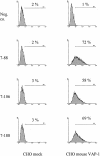
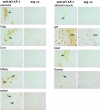
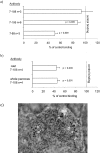
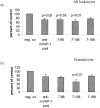
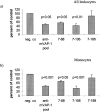



Similar articles
-
Function-blocking antibodies to human vascular adhesion protein-1: a potential anti-inflammatory therapy.Eur J Immunol. 2005 Nov;35(11):3119-30. doi: 10.1002/eji.200535300. Eur J Immunol. 2005. PMID: 16224816
-
Evidence for an enhanced adhesion of DC to fibronectin and a role of CCL19 and CCL21 in the accumulation of DC around the pre-diabetic islets in NOD mice.Eur J Immunol. 2005 Aug;35(8):2386-96. doi: 10.1002/eji.200526251. Eur J Immunol. 2005. PMID: 16047341
-
Small-molecule inhibitors of vascular adhesion protein-1 reduce the accumulation of myeloid cells into tumors and attenuate tumor growth in mice.J Immunol. 2010 Mar 15;184(6):3164-73. doi: 10.4049/jimmunol.0901794. Epub 2010 Feb 12. J Immunol. 2010. PMID: 20154208
-
VAP-1 and CD73, endothelial cell surface enzymes in leukocyte extravasation.Arterioscler Thromb Vasc Biol. 2008 Jan;28(1):18-26. doi: 10.1161/ATVBAHA.107.153130. Epub 2007 Oct 25. Arterioscler Thromb Vasc Biol. 2008. PMID: 17962625 Review.
-
A novel endothelial cell molecule mediating lymphocyte binding in humans.Behring Inst Mitt. 1993 Aug;(92):36-43. Behring Inst Mitt. 1993. PMID: 8250815 Review.
Cited by
-
Leukocyte trafficking-associated vascular adhesion protein 1 is expressed and functionally active in atherosclerotic plaques.Sci Rep. 2016 Oct 12;6:35089. doi: 10.1038/srep35089. Sci Rep. 2016. PMID: 27731409 Free PMC article.
-
Blockade of vascular adhesion protein-1 attenuates choroidal neovascularization.Mol Vis. 2012;18:593-600. Epub 2012 Mar 2. Mol Vis. 2012. PMID: 22419852 Free PMC article.
-
Effects of a germ-free environment on gut immune regulation and diabetes progression in non-obese diabetic (NOD) mice.Diabetologia. 2011 Jun;54(6):1398-406. doi: 10.1007/s00125-011-2097-5. Epub 2011 Mar 5. Diabetologia. 2011. PMID: 21380595
-
Vascular adhesion protein-1 in hemodialysis and hemodiafiltration patients: effect of single hemodialysis session on its level in regard to type of anticoagulant.Int Urol Nephrol. 2017 May;49(5):875-879. doi: 10.1007/s11255-016-1497-3. Epub 2017 Jan 2. Int Urol Nephrol. 2017. PMID: 28044236 Free PMC article.
-
Structure and inhibition of human diamine oxidase.Biochemistry. 2009 Oct 20;48(41):9810-22. doi: 10.1021/bi9014192. Biochemistry. 2009. PMID: 19764817 Free PMC article.
References
-
- Salmi M, Yegutkin G, Lehvonen R, Koskinen K, Salminen T, Jalkanen S. A cell surface amine oxidase directly controls lymphocyte migration. Immunity. 2001;14:265–276. - PubMed
-
- Butcher EC. Leukocyte-endothelial cell recognition: three (or more) steps to specificity and diversity. Cell. 1991;67:1033–1036. - PubMed
-
- Salmi M, Jalkanen S. VAP-1: an adhesin and an enzyme. Trends Immunol. 2001;22:211–216. - PubMed
-
- Jaakkola K, Nikula T, Holopainen R, Vähäsilta T, Matikainen M-T, Laukkanen M-L, Huupponen R, Halkola L, Nieminen L, Hiltunen J, Parviainen S, Clark MR, Knuuti J, Savunen T, Kääpä P, Voipio-Pulkki L-M, Jalkanen S. In vivo detection of vascular adhesion protein-1 in experimental inflammation. Am J Pathol. 2000;157:463–471. - PMC - PubMed
-
- Tohka S, Laukkanen M, Jalkanen S, Salmi M. Vascular adhesion protein 1 (VAP-1) functions as a molecular brake during granulocyte rolling and mediates recruitment in vivo. FASEB J. 2001;15:373–382. - PubMed
Publication types
MeSH terms
Substances
LinkOut - more resources
Full Text Sources
Molecular Biology Databases
Research Materials

